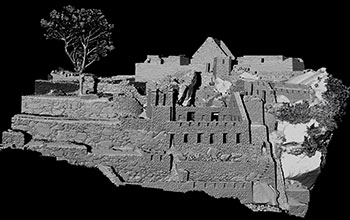Multimedia Gallery
Laser scan of Machu Picchu
A laser scan of Machu Picchu. The data were subset from a single scan and reduced by half (from an original data resolution of 3 centimeters). The scan area covers the central portion of the site and features several structures and a small plaza area. The scan shows the beautiful details of the Incan masonry. This dataset contains slightly less than 1 million data points.
More about this image
This scan was created at the University of Arkansas' Center for Advanced Spatial Technologies (CAST) using the High Accuracy Resolution Landscape and Structure Characterization System, which provides extremely detailed information about targeted surfaces. The system supports high-density surveys of famous archaeology sites such as Machu Picchu. These National Science Foundation (NSF) Major Research Instrumentation program-supported instruments have also been used to scan archaeological artifacts retrieved from archaeological sites and to provide extremely detailed data on the anatomy of skeletons for anthropological research.
Researchers at CAST became involved in archaeological laser scanning in 2003, when they acquired an Optech ILRIS-3D laser scanner with funding from an NSF Major Research Instrumentation grant (BCS 0321286).
In addition to archaeological laser scanning, CAST team members have conducted high-resolution, shallow, subsurface geophysical surveys and digital aerial photogrammetry at the city of Tiwanaku site in Bolivia. This work was supported, in part, by two NSF grants: "Acquisition of a High Accuracy/Resolution Landscape and Structure Characterization System for Anthropology, Archaeology, Architecture, Biology and Geosciences" (BCS 0321286) and "Computing and Retrieving 3D Archaeological Structures from Subsurface Surveying" (IIS 0431070). (Date of Image: 2006)
Credit: Angie Payne, University of Arkansas; Distributed under Creative Commons license under the conditions Attribution, Noncommercial, ReMix and Share Alike. Visit CC website.
Special Restrictions: Distributed under Creative Commons license under the conditions Attribution, Noncommercial, ReMix and Share Alike. Visit CC website.
Images and other media in the National Science Foundation Multimedia Gallery are available for use in print and electronic material by NSF employees, members of the media, university staff, teachers and the general public. All media in the gallery are intended for personal, educational and nonprofit/non-commercial use only.
Images credited to the National Science Foundation, a federal agency, are in the public domain. The images were created by employees of the United States Government as part of their official duties or prepared by contractors as "works for hire" for NSF. You may freely use NSF-credited images and, at your discretion, credit NSF with a "Courtesy: National Science Foundation" notation.
Additional information about general usage can be found in Conditions.
Also Available:
Download the high-resolution JPG version of the image. (577.9 KB)
Use your mouse to right-click (Mac users may need to Ctrl-click) the link above and choose the option that will save the file or target to your computer.

